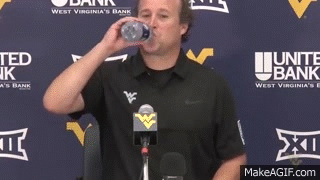Over at Football Study Hall I did a post on the increasing use of iso run schemes amongst smashmouth spread teams. The smashmouth spread in general is starting to evolve into just becoming “spread-iso” football. By that I mean that the goal is basically to spread teams out, find the weak spot, and hammer it OR get your best player matched up on a weak spot and then feed him.
The Houston Rockets’ or Cleveland Cavs’ offensive strategies in basketball are a good analog. Each one was using spread pick’n’roll with the ultimate goal of putting James Harden or LeBron James in a mismatch from which they could create offense.
Iso runs are a major part of the K-State offense but Iowa State also uses some iso and we may see more of it from Texas with Herb Hand this year. Oklahoma State uses a ton of lead runs, whether iso in particular is part of the package I’d have to check my notes to verify but they make heavy use of the lead insert in either event.
Meanwhile, I have another post up on Penn State who mixed spread-iso and spread-option tactics last year, and their creative solution to the “what if our back-up QB transfers???” dilemma.
Their back-up, Tommy Stevens, is a special athlete at 6-5, 230 but he’s been sitting behind a guy that will probably hold every significant Penn State passing record when he graduates in Trace McSorley. So they’ve been working on two-QB packages to try and keep Stevens involved while he patiently waits his turn for the big senior year after McSorley moves on. If nothing else it’s helped them hang on to Stevens and buy time to develop more QBs to keep their current run of success going.
We may or may not see anything like this in the Big 12, where the problem of QB depth is often solved by poaching transfers from schools that haven’t solved this issue. The NCAA just passed two rules that could impact this whole thing, the first allowing teams to redshirt any players that have played less than five games.
That is going to allow teams to involve QBs more quickly while still using their redshirts, which is going to cut into the ability of a young QB who can’t crack the depth chart to transfer and use his redshirt to eat the year he sits out at the new school.
But the NCAA also just passed a rule that doesn’t require that a player notify a school of which programs he wants to talk to about transferring. Now…obviously schools were cheating this system anyways but this should make it easier for schools to recruit transfers from other schools.


“By that I mean that the goal is basically to spread teams out, find the weak spot, and hammer it OR get your best player matched up on a weak spot and then feed him.
Each one was using spread pick’n’roll with the ultimate goal of putting James Harden or LeBron James in a mismatch from which they could create offense.”
1. Great idea and article. I was thinking about this before and wondered how it could be done if you are team with maybe one good olinemen and the rest are average to poor. Is there away to isolate that good lineman and run only behind him while making the the rest of the line irrelevant, or at least limit their ability to affect the play? Maybe line splits?
2. Are there ways to consistently get better matchups for linemen(ex: lineman vs Lb or Db) when they play a defensive line that across the board is better then them other than triple option type offensives? I ask because it seems like in the article you can change the assignment for one or two players but in general the rest of the line has to hold with those other players for the play to have a chance even if you get the mismatch you want.
These are good questions. Normally the answer for teams with weaker OL is to minimalize the difficulty of their assignments. Solutions include:
-multiple TE sets so you get more double teams.
-quick spread passing from wide splits so they don’t have to block as long.
-Run the QB to get extra numbers.
-option schemes that rely on cut blocks.
1). That’s tough, you could get pretty transparent in a hurry that way. I will say that the 2016 Texas offensive line went:
LT: above average
LG: average
C: average
RG: slightly above average
RT: below average
They ran a ton of inside zone and D’Onta Foreman went for 2k yards while usually cutting behind the LT/LG tandem. With inside zone the ball can hit at multiple spots so the back could often default to cutting behind the star blocker.
2. K-State uses splits a lot to create angles, often making the aiming point of their ISO schemes more transparent. Seems to work out okay but they don’t play scrubs.
Usually it’s easier to set up a skill player and just lean on him to help everyone else.